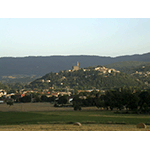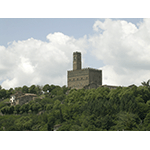Biblioteca Comunale Rilliana - Castello dei Conti Guidi [Rilliana Municipal Library - Castle of the Guidi Counts]
The Library is named for Count Fabrizio Rilli Orsini who, in 1825, donated to the Commune of Poppi his splendid library containing 9000 volumes and 200 manuscripts, along with the building in which it was housed and a modest income. Noteworthy among the manuscripts is an anonymous herbarium from the 17th century, composed of 323 samples, almost exclusively medicinal plants, classified on the basis of the 1684 edition of the Herbario nuovo by Castore Durante.
Enriched by important purchases and donations, such as the Soldani library and documents coming from suppressed monasteries, among them Camaldoli, in 1911 the Rilliana was moved to the medieval Castle of the Guidi Counts, a place of significance for science not only for the documents found in the historic section of the library (nautical charts, scientific texts, etc.), but also for a series of experiments with electricity. In 1786, at the order of Grand Duke Leopold of Lorraine, a conductor of electricity, one of the first lightening rods, was placed on top of the castle’s tower as an experiment. It was built with a double termination, a ball and a point, to test which of the theories on the correct shape for a lightening rod was correct, that of Franklin or that of Wilson. The observations, verified by competent officials, were noted with interest by Felice Fontana and Giovanni Fabbroni. In realty, the conclusions reached by Coulomb were already known; he had settled the dispute, with an ingenious physical demonstration, in favour of the point-shaped termination.
****************************
Texts by Anna Toscano
English translation by Catherine Frost
Last update 22/feb/2008





